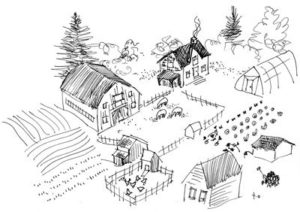 |
| Toki Oshima drawing |
By Jean English, Editor, The Maine Organic Farmer & Gardener
Ben Falk, in his keynote speech at the Common Ground Country Fair, called for a billion new gardeners, because “we have everything we need right here, right now” to re-establish the perennial-based, diverse and integrated food-producing ecosystems that were here for thousands of years.
“We fed ourselves for a very long time,” said Falk, “from gardening small plots of land, hunting, gathering.”
Hilal Elver echoed this idea in her first speech as the UN’s Special Rapporteur on the Right to Food. Governments, she said, must support “agricultural democracy” to empower rural small farmers, who provide 70 percent of food consumed globally, by directing research and funding toward them and toward agroecological methods rather than conventional industrial monoculture agriculture. Environmental issues associated with the latter threaten land, water and resource availability and do not address root causes of hunger, said Elver.
Data confirm those threats.
Former EPA scientist Ramon Seidler says, for example, that reports that genetically engineered (GE) crops have reduced pesticide use don’t count the systemic neonicotinoid insecticides widely applied to seeds. (Neonicotinoids, or “neonics,” are synthetic nicotine insecticides that are very toxic to the nervous system. “Systemic” means they are taken up by plants. Even small amounts have broad effects on non-target species, especially pollinators.) Seidler also says USDA data show that since 1996, use of the herbicide glyphosate (also systemic, and widely used with GE crops) has increased some 12-fold, that overall herbicide use has increased by more than 500 million pounds and that insecticide use has dramatically increased since 2010.
Humans should be concerned about the increased use of water-soluble neonics and glyphosate. This year U.S. Geological Survey scientists found neonicotinoids in all watersheds tested and throughout the growing season in six states and nine Midwestern rivers. Another study found at least one neonic in all produce samples (except nectarine and tomato) and 90 percent of honey samples. And 72 percent of fruits, 45 percent of vegetables and 50 percent of honey samples had at least two different neonicotinoids per sample.
Regarding glyphosate, Danish farmer Ib Borup Pederson saw striking deformities in his pigs when he fed them GE crops that had been grown with glyphosate. When he switched his pigs to non-GE feed, they became healthier, more productive and more profitable, and suffered fewer birth deformities. The 2.58 ppb concentration of glyphosate in Pederson’s own urine (“not from eating GM contaminated feed but from eating normal food from the Danish shops”) was at the level that caused higher rates of abortions and deformities in his pigs.
Fortunately alternatives to these toxic ways to grow food are abundant and can be productive.
André Leu, president of the International Federation of Organic Agricultural Movements (IFOAM), spoke at the Common Ground Country Fair about a large-scale study of small farmers in Africa. “When we taught these farmers good organic techniques on top of their traditional systems – how to compost, better weed and water management – on average we got 116 percent increase in yields.” The increases changed families’ lives and invigorated communities.
Family farmers in the developing world, said Leu, produce 80 percent of the food in their countries on 5 acres or less of land each. Globally that figure is 70 percent. With the potential for at least 100 percent increases in yield, “you can take 70 percent of the world’s food production and double it to 140 percent – that’s something GMOs [genetically modified organisms – also called GE crops] can’t do. We do that. We feed the world.
“And we don’t need to spend hundreds of billions of dollars developing GMOs. We just need education and training. It’s simple. For a fraction of the cost of developing a few GMOs, we could use that money for education and training, and we could take that 800 million people out of poverty within two to three years.”
This issue of The MOF&G covers the talks and news items noted above – and includes articles about growing food organically, and about thinking in terms of what Peter Kellman calls “Agri-culture.”
Enjoy! And thanks for farming, gardening and eating organically!
